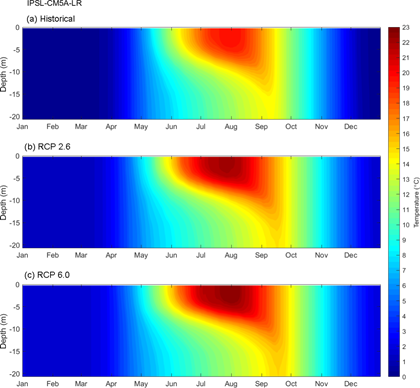Ana Isabel Ayala, a PhD student at the Department of Ecology and Genetics at Uppsala University, recently completed a set of comprehensive simulations showing future changes in Lake Erken’s water temperature and thermal structure.
The work contributes to the Inter-Sectoral Impact Model Inter-comparison Project. It examines the potential changes that can be expected under a stringent mitigation scenario (Graph (b), RCP 2.6) and an intermediate scenario (Graph (c), RCP 6.0). The RCP 2.6 scenario keep global warming below 2 ⁰C above pre-industrial temperatures by 2100. In contrast, under the RCP 6.0 scenario the global mean temperature will continually increase by 2.5 ⁰C and 4 ⁰C by the end of the century. Under the most optimistic assumptions (RCP 2.6) the lakes surface temperature was projected to increase by approximately 1.8 ⁰C and the length of the stratified period would increase by approximately 2 weeks by the end of this century. However, under the intermediate pathway (RCP 6.0) a surface water temperature increase of up to 3 ⁰C and a 22 days longer stratified period are predicted. The graph illustrates the average water temperature heat maps calculated over the entire historical control period and the two future RCP 2.6 (stringent mitigation scenario) and RCP 6.0 (intermediate scenario) scenarios. This clearly illustrates that future water temperatures will be warmer, and that thermal stratification will be more stable and longer lasting.

SITES Water measurements of lake water temperature were used extensively to calibrate and validate the GOTM hydrodynamic lake model used to make these simulations. Meteorological data collected from Malma Island in Lake Erken were used to test the quality of the model, which ultimately allowed many hundred years of simulations to be run in a more effective manner. The publication describing this work is available here.